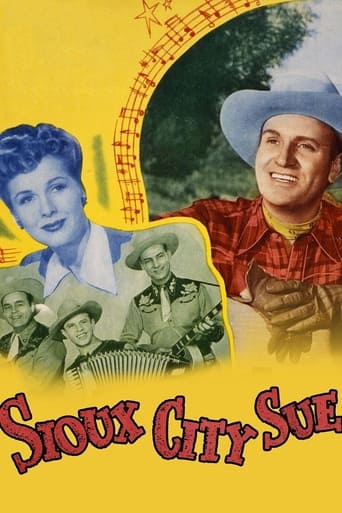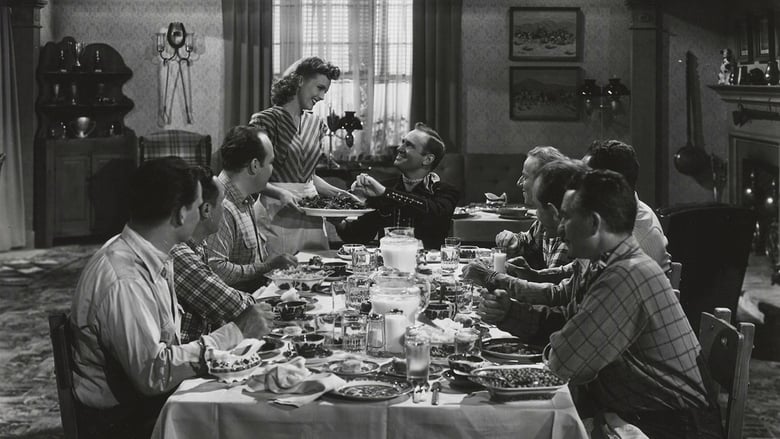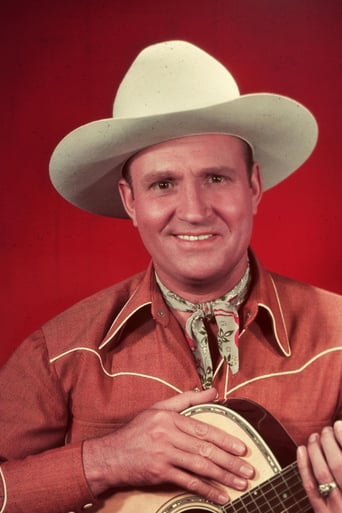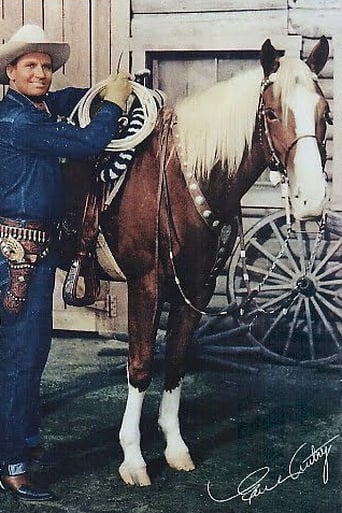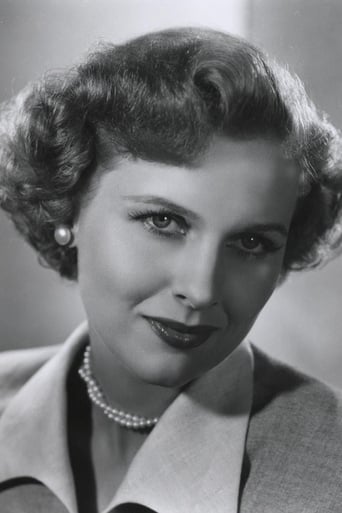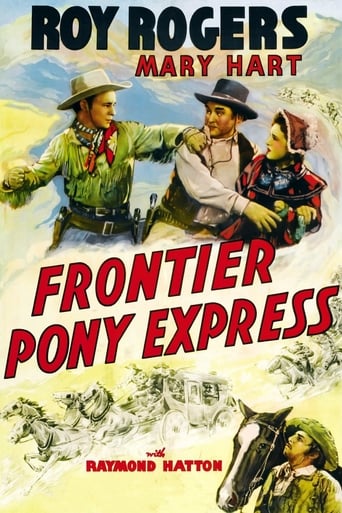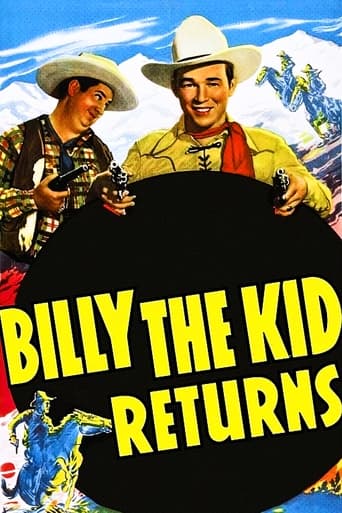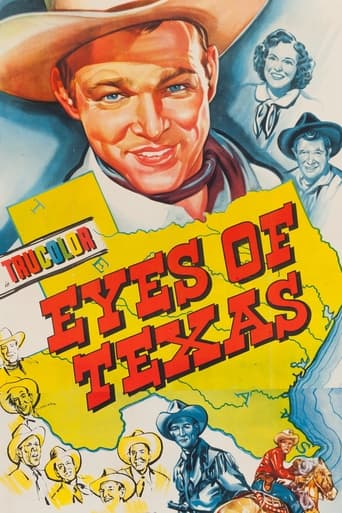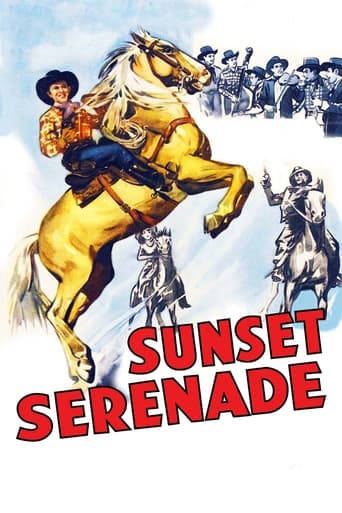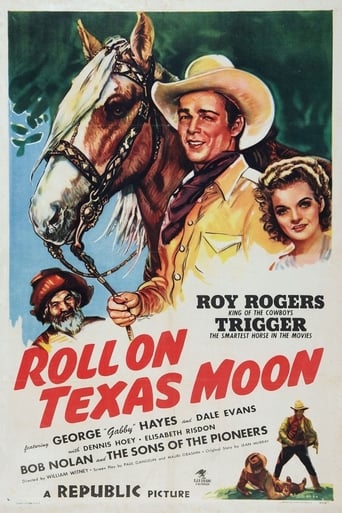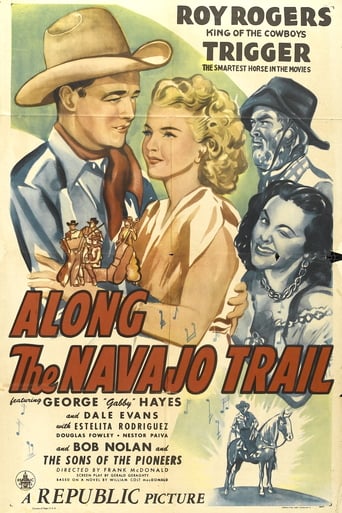Sioux City Sue (1946)
A Hollywood scout averts disaster for a singing cowboy she has misled.
Watch Trailer
Cast


Similar titles
Reviews
By way of contrast with his most expensive and good-by-to-Hollywood movie, "Bells of Capistrano", Gene Autry's comeback movie after his four-year stint in the Army Air Force, "Sioux City Sue" (1946), rates as more than something of a disappointment. Smiley was gone - he was now partnering Charles Starrett at Columbia - and Gene himself was somewhat chubbier. For a new partner, Gene settled on Sterling Holloway of all people, because "he was a veteran and I thought audiences would react favorably to him on that score. I was wrong, of course. I forgot how quickly people forget!"Worse, Holloway seems to be competing against Gene rather than acting with him. And even far less subtle in his approach, Richard Lane seems determined to direct all audience attention HIS way. Despite its movie-making background, the plot makes little sense - although it's nice to see photographer Reggie Lanning riding the camera car. The lovely Lynne Roberts offers some consolation, and the title song is put across with admirable gusto, but all in all, "Sioux City Sue" is a miss!
A highly enjoyable Autry western, boosted by a spirited supporting cast, a non-formula script, and a sprinkling of very listenable songs including the delightful title number. Autry was always an unlikely cowboy hero, short, stout, and wooden, yet his way with a song was always pleasant and natural, while his horsemanship and fight scenes were as convincing as any. His secret of success may well have been his ordinariness. Unlike a towering John Wayne, Crash Corrigan, or innumerable other icons of the Saturday matinée, Autry was always within reach of the audience, a reassuring nearness for those of us who knew we would never grow into the boots of a Wayne or Corrigan. Anyway, I suppose the audience for this kind of innocent bucolic fun dwindles each year as we matinée kids age and shuffle off, leaving such fare to film historians and curiosity seekers. Historians should find this film particularly revealing for its behind-the-scenes look at the making of musical westerns, and also for a fluttery Sterling Holloway, a most unlikely comic relief for the macho western, which, I suppose, amounted to someone's comment on the film industry since he appears as a production assistant. The leading lady also goes against type. A hard-driving studio scout, who overshadows the laid-back Autry, she defies patriarchal expectations by remaining with the studio at film's end. All in all, this programmer rises above the low expectations of a cowboy movie and remains well worth a look on several levels.
This action-filled Gene Autry entry indicates that Gene had lost none of his horse-opera appeal to his legion of fans following his service to our country in World War II. This was one of Gene's last films at Republic to fulfill his contract before ending his screen career with Columbia over another ten-year period, a decade which saw Gene successfully make the transition from movies to the new medium of television, which along with wise investments made him one of the wealthiest men around.As a kid in the early 50's, I saw tons of Saturday matinée fodder. Most I don't recall, though I do remember the cowboy stars and their sidekicks. "Sioux City Sue" is an exception. I vividly remember the cartoon of the donkey with Gene Autry's voice warbling "Ridin' Double." In those halcyon days, big Hollywood stars thought it condescending to talk for cartoon characters, unlike today when movie icons find it highly lucrative and completely acceptable by their fans to be the voice of animated figures. In 1946, voice impersonators such as Mel Blanc often imitated stars such as Bogart, Bette Davis, and Gable, but those matinée idols would never have consented to do the voices themselves. Knowing that, today's viewer can well understand how embarrassing a western personage such as Gene Autry would feel seeing an animated donkey lip sync to one of his songs. That is also why this sequence is so memorable for the ones who saw it when released or re-released.There is no Smiley Burnette to assist Gene with the songs and humor. He was now tied up with other partners, Sunset Carson, Charles Starrett, and the like. Pat Buttram had yet to enter the picture. Actually, for his first post-war outing, Gene has no comical sidekick. The marvelous Sterling Holloway (who later was the voice of an animated character of his own, "Winnie the Pooh") is in cahoots with those attempting to exploit Gene's talents. Though comical, he is a sycophant for the studio big wigs.There are several good songs in "Sioux City Sue," even if it is easy to tire quickly of the title ditty, one of the big hits of 1946. Woody Guthrie's "Oklahoma Hills" is one of his best, co-written by Woody's cousin who recorded the hit version of this autobiographical creation. Besides "Oklahoma Hills," the other gem is Jimmy Hodges's "Someday You'll Want Me To Want You," recorded by many artists over the years, including Jerry Lee Lewis, Brenda Lee, and Ray Charles. Gene does such an admirable job singing it that he repeats it three times before the film is over. His amour is the captivating Lynne Roberts who plays Sioux City Sue Warner. Helping Gene in the singing department are the Cass County Boys, not the Sons of The Pioneers but not bad.The story is easy to follow. A Hollywood studio looking for a singing cowboy finds Gene and in the process nearly bankrupts him. He is offered a part in a picture, not knowing that it is a voice over for a cartoon. Humiliated Gene walks out of the film preview. Sue Warner becomes distraught over the situation and seeks forgiveness. Testing her sincerity, Gene offers her the job of chief cook and bottle washer. She comes to love the ranch and the cowboy way of life. In the meantime, the studio head sees the film footage of the real-life Gene in action and orders his underlings to find the cowboy and sign him up. One of the men Gene had a run-in with and beat up decides to get revenge by blowing up the dam to flood Gene's ranch and drown his cattle. This segment of the picture is one of the highlights, with effective camera shots and daredevil stunt work."Sioux City Sue" lets everyone know that Gene Autry is back in town and ready for action.
Fun Autry film with less music and action than usual, but more outright comedy, in a better story than some he's done. This one has him going to Hollywood to raise money to save the ranch (which was only imperiled by the Hollywood duo, Roberts and Holloway, driving their car through their cattle drive, in the first place) and being tricked into providing the voice for an animated donkey -- literally making an a@* out of himself before his amused "manly" fellows and townsfolk. Of course, his "real" acting talent is discovered and yes, he does get the talent-scout girl.OK directing and OK acting from the support crew. Nice to see Autry in a bit of a different movie.

